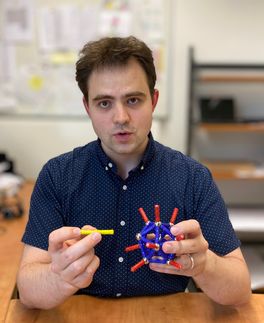Now Available with a Negative Charge too
Stabilization of the borafluorene anion with carbenes
The incorporation of boron into polycyclic aromatic hydrocarbon systems leads to interesting chromophoric and fluorescing materials for optoelectronics, including organic light-emitting diodes (OLEDS) and field-effect transistors, as well as polymer-based sensors. In the journal Angewandte Chemie, a research team has now introduced a new anionic organoborane compound. synthesis of the borafluorene succeeded through the use of carbenes.

© Wiley-VCH
Borafluorene is a particularly interesting boron-containing building block. It is a system of three carbon rings joined at the edges: two six-membered and one central five-membered ring, whose free tip is the boron atom. While neutral, radical, and cationic (positively charged) borafluorene compounds are quite easy to produce, there have been few examples of anionic (negatively charged) borafluorene compounds to date. Better understanding of their chemistry is important for advances in redox-dependent applications and could lead to new materials with unique bonding or optical properties. However, the relatively high reactivity of borafluorene anions makes their synthesis challenging. A team led by Robert J. Gilliard, Jr. at the University of Virginia Charlottesville, USA) and David J. D. Wilson at Latrobe University (Melbourne, Australia) has now succeeded in the isolation and structural characterization of these elusive anions.
The starting point for their new synthesis is 9-bromo-9-borafluorene, which has a bromine atom attached to its boron atom. This is treated with a very strong reducing agent (potassium graphite, sodium naphthalenide, or lithium naphthalenide) in the presence of special carbenes (organic compounds with a divalent carbon atom and a free electron pair). The anionic borafluorenes formed in the reduction are stabilized by the carbenes.
As the team demonstrated, the carbene-borafluorene anions can also be used as chemical building blocks. This makes it possible to produce new compounds that are not otherwise accessible with previously known starting materials. For example, compounds with bonds between boron and gold, selenium, or germanium were generated. Reaction with a diketone led to a ring closure and bonding of the boron atom to both ketone oxygens, forming what is known as a spirocyclic boron compound.
Original publication
Other news from the department science
Most read news
More news from our other portals
See the theme worlds for related content
Topic world Synthesis
Chemical synthesis is at the heart of modern chemistry and enables the targeted production of molecules with specific properties. By combining starting materials in defined reaction conditions, chemists can create a wide range of compounds, from simple molecules to complex active ingredients.

Topic world Synthesis
Chemical synthesis is at the heart of modern chemistry and enables the targeted production of molecules with specific properties. By combining starting materials in defined reaction conditions, chemists can create a wide range of compounds, from simple molecules to complex active ingredients.






























































